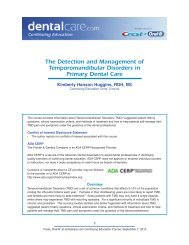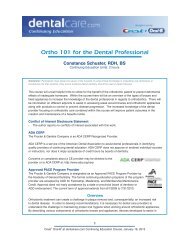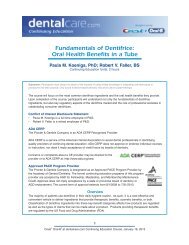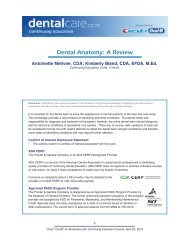CE 391 - Management of Pediatric Medical ... - DentalCare.com
CE 391 - Management of Pediatric Medical ... - DentalCare.com
CE 391 - Management of Pediatric Medical ... - DentalCare.com
Create successful ePaper yourself
Turn your PDF publications into a flip-book with our unique Google optimized e-Paper software.
In a survey conducted at the 2004 American<br />
Academy <strong>of</strong> <strong>Pediatric</strong> Dentistry “<strong>Pediatric</strong><br />
Emergencies in the Dental Office” course, the<br />
incidence <strong>of</strong> specific emergency situations<br />
reported by 66 pediatric dentists over a 10 year<br />
period were:<br />
Incidence <strong>of</strong> Specific Emergency Situations<br />
The dental <strong>of</strong>fice’s successful management<br />
<strong>of</strong> medical emergencies requires preparation,<br />
prevention and response not just by the dentist<br />
but by all dental staff.<br />
Preparation<br />
Adequate preparation for emergencies reduces<br />
the possibility <strong>of</strong> an emergency occurring and<br />
further <strong>com</strong>plications if it does occur. Preparation<br />
steps include:<br />
• Taking and reviewing a <strong>com</strong>prehensive<br />
medical and dental history.<br />
• Providing minimum basic life support (BLS)<br />
training for providers and staff.<br />
• Advanced Cardiac Life Support (ACLS) or<br />
<strong>Pediatric</strong> Advanced Life Support (PALS)<br />
training especially for those administering<br />
sedation and general anesthesia.<br />
• Initiation and coordination <strong>of</strong> an <strong>of</strong>fice<br />
emergency team.<br />
• Organizing an emergency drug kit and<br />
equipment.<br />
• Retraining on a regular basis.<br />
<strong>Medical</strong> and Dental History<br />
Taking a <strong>com</strong>prehensive medical and dental<br />
history and noting not only contraindications to<br />
dental treatment but also previous medical and<br />
3<br />
psychological experiences that can precipitate a<br />
medical emergency alerts the clinician and staff<br />
to any precautions or preparations that need to<br />
be taken to avert and manage an emergency. A<br />
diabetic patient may not only have <strong>com</strong>promised<br />
healing but may undergo a hypoglycemic<br />
incident because <strong>of</strong> low blood glucose level<br />
due to not eating or excessive stress before<br />
and during treatment. Patients and parents<br />
<strong>of</strong> pediatric patients with previous negative<br />
dental experiences may develop syncope prior,<br />
during, and post treatment due to anticipated<br />
or unanticipated dis<strong>com</strong>fort, the sight <strong>of</strong> dental<br />
instruments, or upon seeing blood drenched<br />
gauze. The patient’s medical problems and<br />
related potential emergency situations should be<br />
noted in a prominent location in the patient’s chart<br />
so staff can prepare the necessary emergency<br />
drugs and equipment prior to seating the patient.<br />
Staff Training and Duties<br />
All staff should receive training in recognition <strong>of</strong><br />
emergency situations and basic life support. A<br />
receptionist at the front desk will be the one most<br />
likely to be alerted to an emergency in the waiting<br />
area. All staff should be familiar with the location<br />
<strong>of</strong> the emergency drug kit and monitoring and<br />
resuscitation equipment as well as the procedure<br />
for contacting EMS. For greater efficiency, each<br />
staff member should be assigned a predefined<br />
role during an emergency. Periodically these<br />
roles should be reassigned to other personnel<br />
so staff is familiar with all aspects <strong>of</strong> emergency<br />
management. An efficient emergency team can<br />
be organized with as few as two or three staff. In<br />
<strong>of</strong>fices where sedation and general anesthesia<br />
is administered training in PALS or ACLS is<br />
re<strong>com</strong>mended (and in some states required) for<br />
the clinical staff. A suggested assignment <strong>of</strong><br />
duties follows:<br />
Team member #1 is the first person on the<br />
scene when the emergency occurs. Thus, every<br />
staff member should be familiar with the Team<br />
Member #1 duties since an emergency can occur<br />
in any location within the <strong>of</strong>fice. After the initial<br />
activation <strong>of</strong> the emergency team, a team with<br />
advanced training can assume the role <strong>of</strong> Team<br />
Member #1. Upon discovery <strong>of</strong> an emergency<br />
patient, this member’s responsibilities include:<br />
• Alerting other <strong>of</strong>fice staff members.<br />
• Activating Basic Life Support (Positioning,<br />
Airway maintenance, Breathing, Circulation,<br />
Crest ® Oral-B ®<br />
at dentalcare.<strong>com</strong> Continuing Education Course, May 11, 2012
















